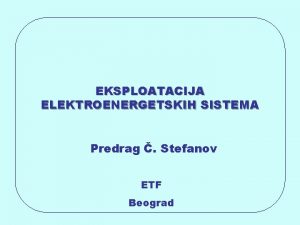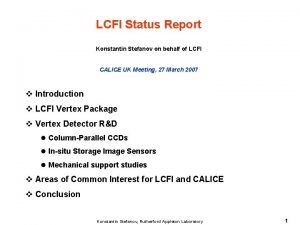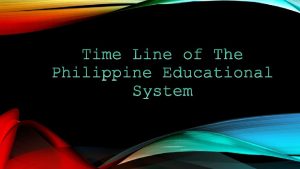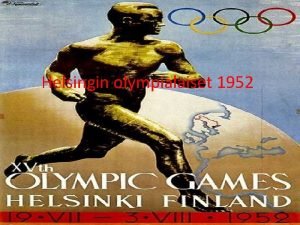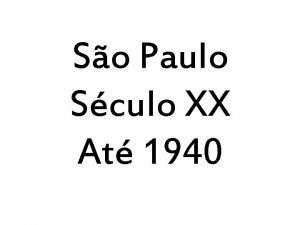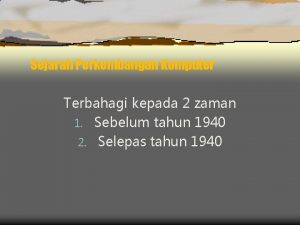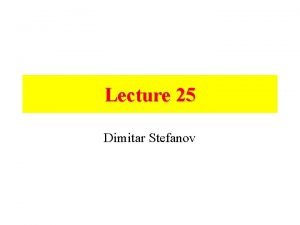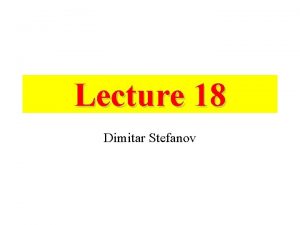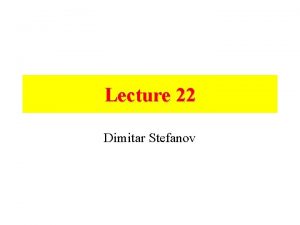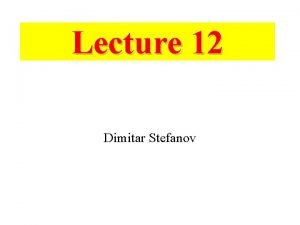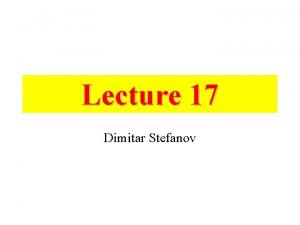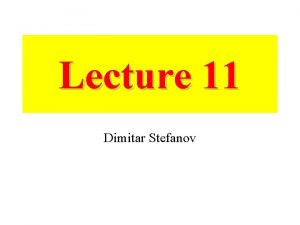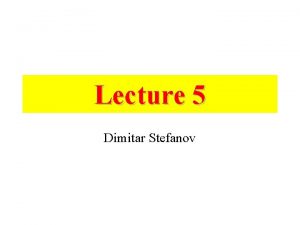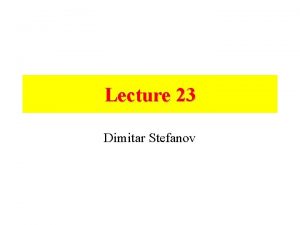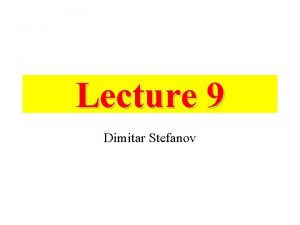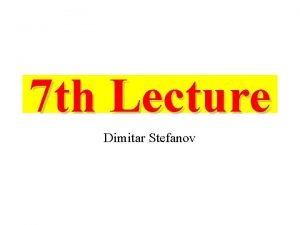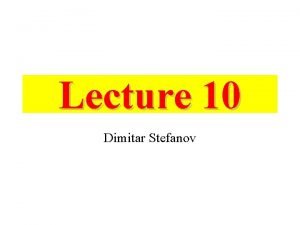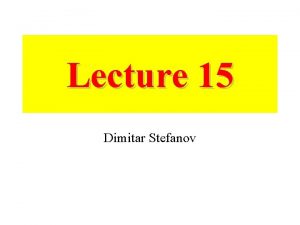Lecture 19 Dimitar Stefanov Powered Wheelchairs 1940 s













- Slides: 13

Lecture 19 Dimitar Stefanov

Powered Wheelchairs • 1940 s – first powered wheelchairs, standard manual wheelchairs adapted with automobile starter motors and automobile battery Prescription of the type of the wheelchair depends on the user’s mobility. In some cases – manual wheelchair for indoor and sortdistances and a powered wheelchair for long distances.

Powered wheelchair with combination of other devices – communication devices, computer access devices, respirators, and reclining seating systems. 54 commands HMI by voice, switch, joystick, wheelchair controls. NEMO, Madentec Limited, http: //www. madenta. com/

Depending on their construction: 1. Power bases 2. Power wheelchairs 3. Scooters. Four classes wheelchairs (depending on their power): Class 1 – carry up to 100 kg, maximal speed of 1. 1 to 1. 8 ms-1 , capable to carry up to 6° slope, travel over than 10 km on a single charge, climb a 25 mm obstacle, for indoor use Class 2 – carry up to 100 kg, maximal speed of 1. 8 to 2. 7 ms-1 , capable to carry up to 9° slope, travel over than 16 km on a single charge, climb a 50 mm obstacle, designed for indoor and moderate outdoor use. Class 3 – carry up to 113 kg, maximal speed of 1. 8 to 2. 7 ms-1 , capable to carry up to 9° slope, travel over than 16 km on a single charge, climb a 50 mm obstacle, designed for active indoor and outdoor use. Class 4 – carry up to 130 kg, maximal speed of 10 to 12 km/h , capable to carry up to 15° slope, travel over than 35 km on a single charge, climb a 150 mm obstacle, designed for active outdoor use in heavy terrains.

Scooter – an example Front-wheel driven (for indoor use) Rear-wheel driven (for indoor and outdoor use) Scooter can be broken down to fit into the trunk of an automobile.

Powered wheelchair system schematic Electromagnetic brakes immobilize the wheelchair in case of inclined ground surfaces

Motor selection: • Armature controlled permanent magnet direct current motors – high torque, high start torque, simplest control In some prototypes: • Brushless motors • AC motors – special controllers, where the motor power is changed by varying the frequency of the motor supply. Power rate of the DC motor – describes the ability of the motor to transfer electrical power to mechanical power. Motor control of powered wheelchair Dynamic stiffness – how closely a moving system follows a desired motion profile in the presence of disturbance torques. Closed-loop systems are used to increase the dynamic stiffness.

Bandwidth – the limiting frequency of motion commands to which a system can respond Speed contour of the controller Typically – 150 -250 Hz Servo controllers Velocity reference + + Switching drive M Current sensor Velocity sensor Voltage control is used to control the motor speed Current contour (inner) Speed contour (outer) Switching (or chopper) drive

Switching drive: 1. Unidirectional (half-bridge) – used in scooters 2. Bi-directional (full-bridge, H-bridge) Speed reverse by relay Switching drive: 1. With dynamic braking 2. Without dynamic braking Pulse – width modulation (PWM) Frequency – 5 -30 KHz

R Pulse Generator L DC motor Motor current in the switch mode: 1. Imax should be limited to 5 times the rated current of the motor to insure that demagnetization does not occur 2. The ripple (Imax – Imin)/Iaverage should be minimized to improve the form factor, and reduce the conduction loss in the switching devices.

Switching elements: 1. Silicon controlled rectifiers (SCR) – old constructions 2. Powder metal oxide semiconductor field effect transistors (MOSFETs) • Powered wheelchairs based on SCR use typical switching frequencies of 500 -1000 Hz. • Powered wheelchairs based on MOSFETs use typical switching frequencies of 5 -30 KHz. Efficiency – 90%. - excellent to battery application.

Basic Full-bridge circuit • High forward voltage (up to 50 V) on the MOSFETs transistors during the turn-off period due to the motor inductivity. • Multiple MOSFETs transistor in parallel in order to achieve big output currents.

• Typically - MOSFETs transistors rated at 100 V and 30 -50 A continuous operation. • In some constructions – up to 8 transistors, connected in parallel to increase the reliability of the wheelchair • Dynamic braking – special fast recovery diodes are switched in parallel of the MOSFETs and the motor ; During the braking process the current is returned back to the supply, i. e. the battery is charged during braking.
 John nochev
John nochev Koga e roden vasil levski
Koga e roden vasil levski Dimitar sasselov
Dimitar sasselov Dnevni dijagram opterećenja
Dnevni dijagram opterećenja Konstantin stefanov
Konstantin stefanov 01:640:244 lecture notes - lecture 15: plat, idah, farad
01:640:244 lecture notes - lecture 15: plat, idah, farad Republic act 5250
Republic act 5250 Tradisjonalisme
Tradisjonalisme Suomen olympialaiset 1940
Suomen olympialaiset 1940 Tom és jerry 2021 teljes film magyarul videa
Tom és jerry 2021 teljes film magyarul videa Camaro 1940
Camaro 1940 Conclusion of lahore resolution
Conclusion of lahore resolution Art deco 1925
Art deco 1925 Sejarah komputer sebelum 1940
Sejarah komputer sebelum 1940



